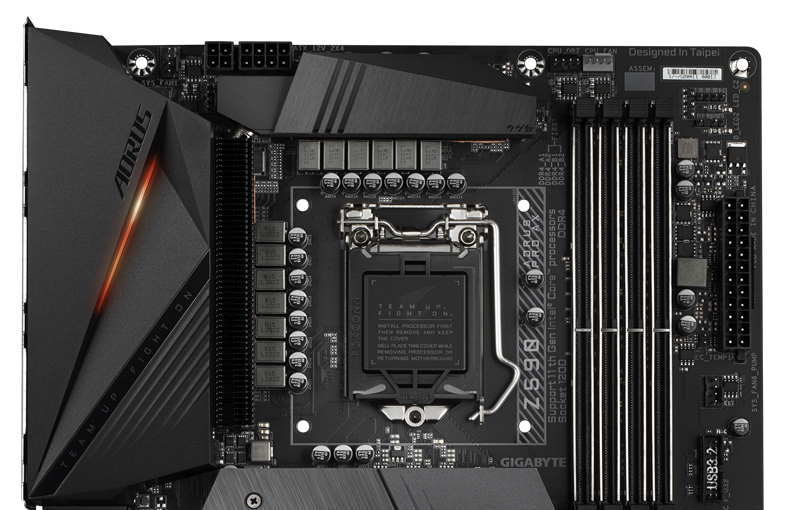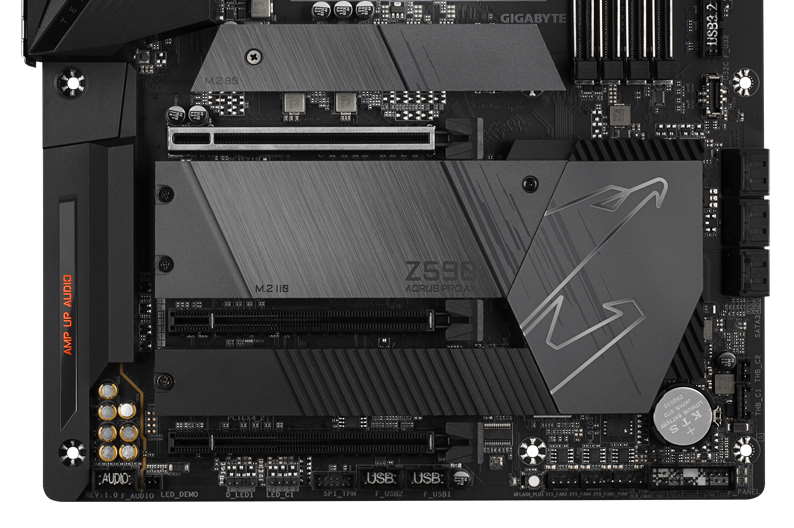Tom's Hardware Verdict
The Gigabyte Z590 Aorus Pro AX is a full-featured Z590 motherboard that includes robust power delivery, premium audio, four M.2 sockets, and 13 USB ports on the rear IO. This $290 board is a good value, especially for those who would like lots of M.2 and USB ports.
Pros
- +
+ 13 rear USB ports. including Type-C Gen 2x2
- +
+ Robust 90A, 12-Phase VRM
- +
+ Four M.2 sockets
- +
+ Latest-gen audio solution
Cons
- -
Integrated Wi-Fi lacks 6E capability
Why you can trust Tom's Hardware
The Gigabyte Z590 Aorus Pro AX positions itself as a mid-range SKU with a modest (for recent motherboard generations) price of $289.99. For that price, you get the most USB ports -- thirteen, including USB 3.2 Gen 2x2 Type-C port -- we’ve seen on any motherboard in quite a while. Additionally, the board includes the latest audio codec, extreme overclocking-capable power delivery and four M.2 sockets. This, coupled with a reasonable price tag, yields a great option fory new Intel-based builds.
Gigabyte’s current Z590 product stack consists of 13 models. There are familiar SKUs and a couple of new ones. Starting with the Aorus line, we have the Aorus Xtreme (and potentially a Waterforce version), Aorus Master, Aorus Ultra, and the Aorus Elite. Gigabyte brings back the Vision boards (for creators) and their familiar white shrouds. The Z590 Gaming X and a couple of boards from the budget Ultra Durable (UD) series are also listed. New for Z590 is the Pro AX board, which looks to slot somewhere in the middle. Gigabyte also released the Z590 Aorus Tachyon (review coming soon), an overbuilt motherboard designed for extreme overclocking.
Overall, performance on the Aorus Pro AX was inconsistent in our testing. Some results were below the average, while others were right there or faster than the pack. For example, the 3D/game testing showed above-average results, while some synthetic tests were slower than others. This board is performant out of the box, with settings that go beyond Intel specifications.
The mid-priced Aorus Pro AX brings users premium features, including 90A MOSFETs, Realtek 4000 series audio, a staggering four M.2 sockets and a slew of USB ports. Gigabyte updated the appearance from the last generation as well. So between the modern appearance and updated hardware, there’s a lot to take in. We’ll cover those and other features in more detail Below. But right out of the gate this looks like a strong contender for our best motherboards list. First, let’s take a look at the full specs list from Gigabyte.
Specifications - Gigabyte Z590 Aorus Pro AX
| Socket | LGA 1200 |
| Chipset | Z590 |
| Form Factor | ATX |
| Voltage Regulator | 12 Phase (12+1+1+2, 90A MOSFETs) |
| Video Ports | (1) DisplayPort |
| USB Ports | (1) USB 3.2 Gen 2x2, Type-C (20 Gbps) |
| Row 6 - Cell 0 | (4) USB 3.2 Gen 2, Type-A (10 Gbps) |
| Row 7 - Cell 0 | (4) USB 3.2 Gen 1, Type-A (5 Gbps) |
| Row 8 - Cell 0 | (4) USB 2.0 (480 Mbps) |
| Network Jacks | (1) 2.5 GbE |
| Audio Jacks | (5) Analog + SPDIF |
| Legacy Ports/Jacks | ✗ |
| Other Ports/Jack | ✗ |
| PCIe x16 | (1) v4.0 x16 |
| Row 14 - Cell 0 | (2) v3.0 x4 |
| PCIe x8 | ✗ |
| PCIe x4 | ✗ |
| PCIe x1 | ✗ |
| CrossFire/SLI | AMD Quad-GPU Crossfire and 2-Way AMD Crossfire |
| DIMM slots | (4) DDR4 5400(OC), 128GB Capacity |
| M.2 slots | (1) PCIe 4.0 x4 / PCIe (up to 80mm) |
| Row 21 - Cell 0 | (2) PCIe 4.0 x4 / PCIe (up to 110mm) |
| Row 22 - Cell 0 | (1) PCIe 3.0 x4 / PCIe and SATA (up to 110mm) |
| U.2 Ports | ✗ |
| SATA Ports | (6) SATA3 6 Gbps (RAID 0, 1, 5 and 10) |
| USB Headers | (1) USB v3.2 Gen 2 (Front Panel Type-C) |
| Row 26 - Cell 0 | (1) USB v3.2 Gen 1 |
| Row 27 - Cell 0 | (2) USB v2.0 |
| Row 28 - Cell 0 | (2) Thunderbolt AIC headers |
| Fan/Pump Headers | (8) 4-Pin |
| RGB Headers | (2) aRGB Gen 2 (3-pin) |
| Row 31 - Cell 0 | (2) Aura RGB (4-pin) |
| Legacy Interfaces | ✗ |
| Other Interfaces | FP-Audio, TPM |
| Diagnostics Panel | 4-LED 'Status LED' display |
| Internal Button/Switch | ✗ |
| SATA Controllers | ✗ |
| Ethernet Controller(s) | (1) Intel I225-V (2.5 GbE) |
| Wi-Fi / Bluetooth | Intel WiFi AX200 (802.11ax, 160 Hz, BT 5.1) |
| USB Controllers | Realtek RTS5411E |
| HD Audio Codec | SupremeFX ALC4080 |
| DDL/DTS Connect | ✗ / ✗ |
| Warranty | 3 Years |
Inside the box along with the motherboard are a slew of accessories. While certainly not the most inclusive we’ve seen, the SATA cables, Wi-Fi Antenna, screws and more, are plenty to get your system build moving along. Here’s everything that Gigabyte includes in the box.
- User’s Manual / Installation Guide
- Q-connector
- Aorus sticker
- Graphics card holder
- Wi-Fi Antenna
- (4) SATA cables
- (3) Screw packages for M.2 sockets
- (1) RGB extension cable
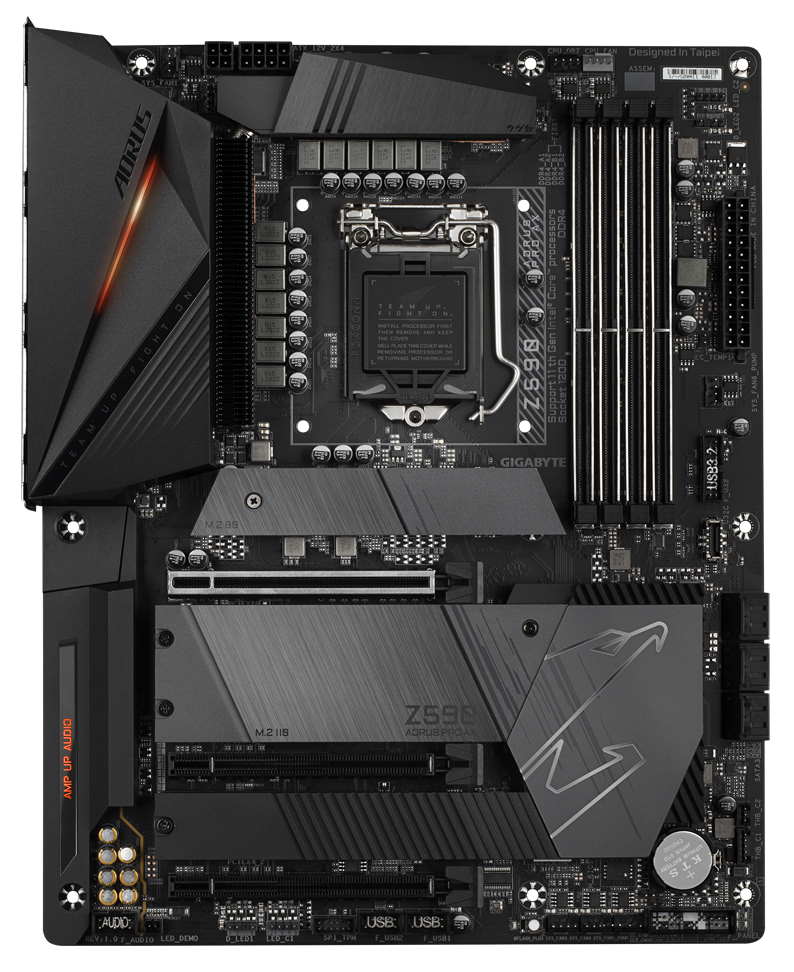
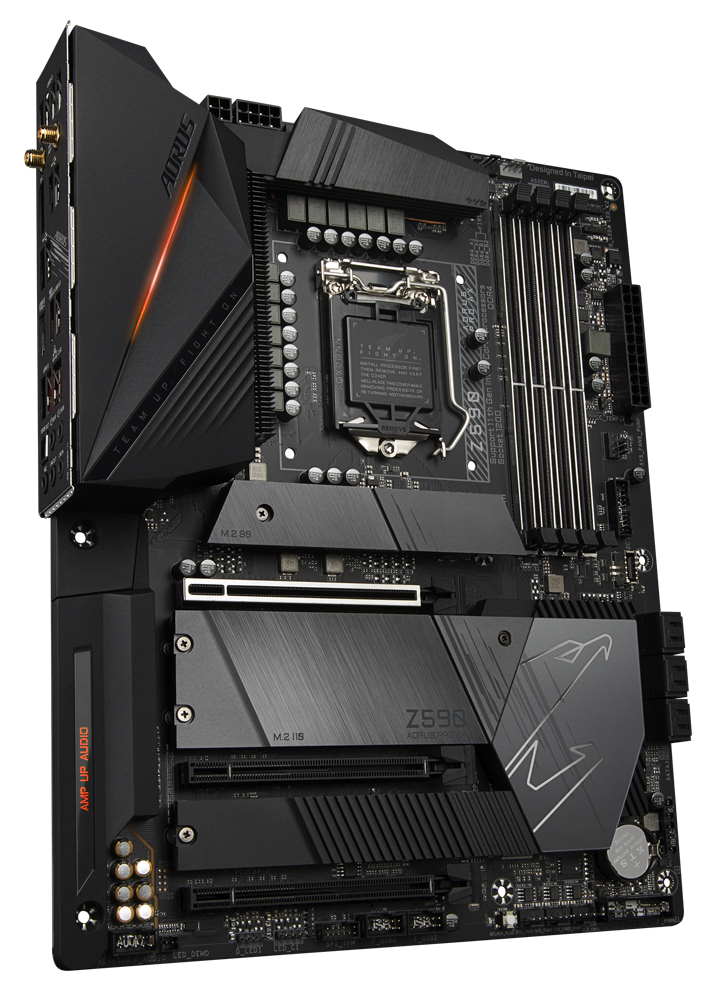
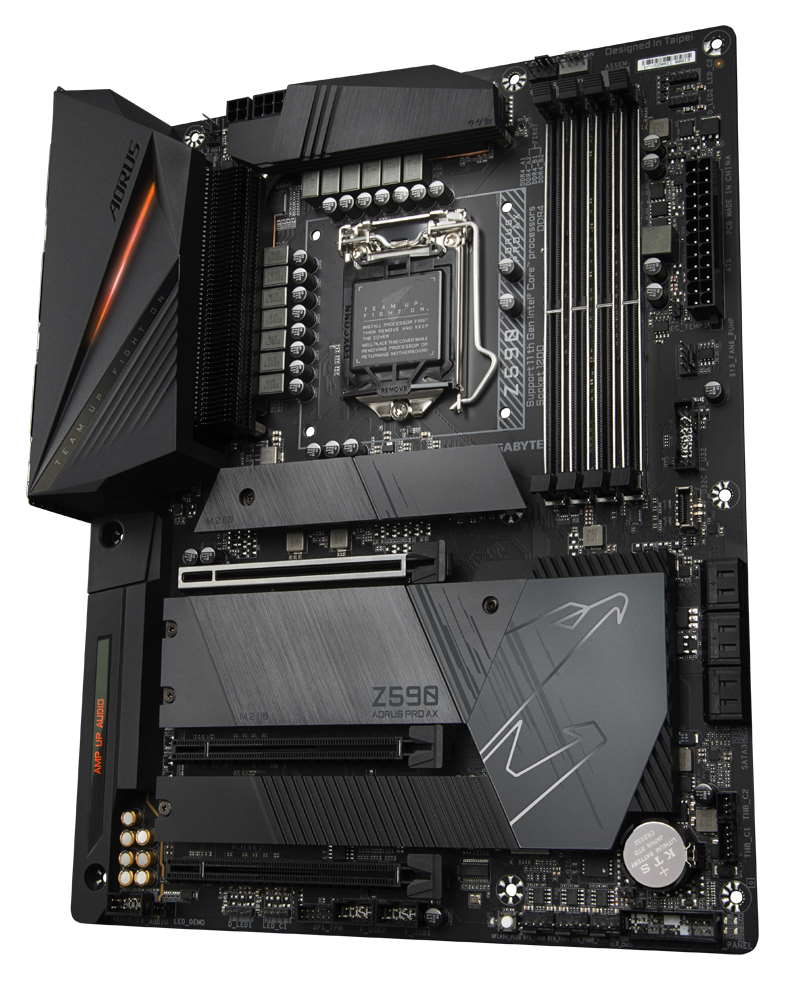
Once we removed the Pro AX from the box, we noticed a few design changes from the Z490 version. The first,the direction of the lines and brushed-aluminum finish on the M.2 and the chipset heatsinks go the other way. Outside of that, the rear IO cover with its single RGB LED strip, VRM heatsinks, matte-black PCB and reinforced slots are familiar carryovers. The audio shroud illuminates the “Amp Up Audio” branding towards the bottom with RGB LED. Those looking for an RGB light show will have to add their own to the internal headers, but what’s here does give off a nice saturated glow, even if it isn’t a disco.
Overall, this board looks good for the price and should fit in with most build themes. The brushed-aluminum accents give this board a more premium appearance than others around the same price point.
Get Tom's Hardware's best news and in-depth reviews, straight to your inbox.
Starting in the upper left, we get a closer look at the shroud with the Aorus branding, along with the “Team Up, Fight On” motto. Between this is a plastic diffuser to thin the light out from the RGB LEDs below. If that shroud looks familiar, it’s because it’s a carryover from the Z490 Pro AX. Moving to the right, we see an 8-pin EPS connector (required) with an optional 4-pin next to it. Also located in this area, curiously, is the first of eight 4-pin fan headers.
The VRM heatsink is the same as Z490, using a large metal sink on the top bank and a finned heatsink over the left bank. As you’ll see later on, this solution does a good job cooling the chips below. Just to the right, above the DRAM slots, are two more fan headers (CPU_OPT and CPU_FAN). All fan headers on this board support both 3-pin and 4-pin fans. Each header outputs up to 2A/24W, which should be plenty for piggybacking a couple of fans, as well as supporting most water pumps.
Just below these headers are the four DRAM slots. Gigabyte reinforces the slots with its Ultra Durable Memory Armor, which improves the appearance, but in general isn’t all that useful -- on any motherboard. The board supports up to 128 GB of RAM with speeds listed up to DDR4 5400, some of the fastest we’ve seen. As always, your mileage may vary as you’ll need the right CPU and memory kit to reach those speeds.
To the right of the DRAM slots are the first set of 3-pin ARGB and 4-pin RGB headers. A little higher up the board than usual is the 24-pin ATX connector for primary power. Below this is a system fan header, a USB 3.2 Gen 1 header and a USB 3.2 Gen 2x2 Type-C header.
The Pro AX uses a 12+1(+1+2) configuration for the Vcore and System Agent. The EPS connector sends power to a Renesas ISL69269 12-channel (X+Y+Z=12) controller. It’s then fed directly (no phase doublers or teaming here!) to 12 Renesas ISL99390 90A Smart Power Stages. This setup yields 1080A available for the CPU. In short, you’ll be limited by the CPU cooling well before the power delivery lets you down here.
As we move to the bottom half of the board, we’re greeted by plastic shrouds and heatsinks covering most of the PCB. On the left side is a plastic shroud that covers a majority of the audio bits. On top is the second and final RGB LED location that lights up the Amp Up Audio branding. Hidden below is the latest generation Realtek ALC4080 codec, along with WIMA audio capacitors for the rear outputs (Gigabyte says 120dB SNR for that output). Also visible are several yellow Nichicon audio capacitors and the audio separation line from the rest of the board. Most users will find this audio solution satisfactory.
In the middle of the board resides the four M.2 sockets and three PCIe slots. To prevent shearing and EMI protection (for what it’s worth), Gigabyte reinforced the top PCIe slot. The top slot is wired directly to the CPU and runs at PCIe 4.0 x16. The two other slots are sourced from the chipset and run at PCIe 3.0 x4 speeds. This configuration supports AMD Quad-GPU Crossfire and 2-Way AMD Crossfire. Since no other slots run at x8 speeds, NVIDIA SLI is not possible. I would like to have seen an additional x1 slot for additional peripherals, but the two full-length slots should be enough for most people.
Laced between and above the PCIe slots are all four M.2 sockets. The top three M.2 sockets are connected via the CPU. The top, M2A_CPU, supports up to 80mm PCIe devices at PCIe 4.0 x4 speeds. The following two sockets, M2B_CPU and M2C_CPU, support up to 110mm PCIe modules at PCIe x4 speeds. The bottom M.2 socket, M2P_SB, is attached to the chipset and runs both SATA and PCIe modules (PCIe 3.0 x4). On this board, SATA port 1 gets disabled when a SATA-based M.2 drive is installed. Not too much to worry about there. The worst case is that you can have four M.2 modules and five or six SATA ports available (depending on what type of module is installed in M2P_SB). That’s a lot of storage without much lane sharing.
To the right of the PCIe/M.2 area is the chipset heatsink with the Aorus falcon on top. To the right of it are six horizontally affixed SATA ports. This board supports RAID0, 1, 5 and 10 modes. Last but not least, just below that next to the CMOS battery are the Thunderbolt 4 AIC headers.
Across the board’s bottom are several headers, including fan and USB, a QFlash button and more. The Aorus Pro AX also has a temperature header on the bottom and includes a sensor for it. This is a good value add for users who would like to ramp up/down fan speeds based on internal chassis temperature. Additionally, in the right-hand corner is the Dr.Debug display. This 4-LED area lights up during the POST process and displays the current stage (Boot, CPU, DRAM and VGA). If there is a problem during this process, the corresponding LED stays lit. Below is the full list of headers and buttons, from left to right:
- Front-panel audio
- RGB and ARGB headers
- TPM header
- (2) USB 2.0 headers
- 2-pin Temperature header
- Q-Flash button
- (3) System fan headers
- Clear CMOS jumper
- Front panel header
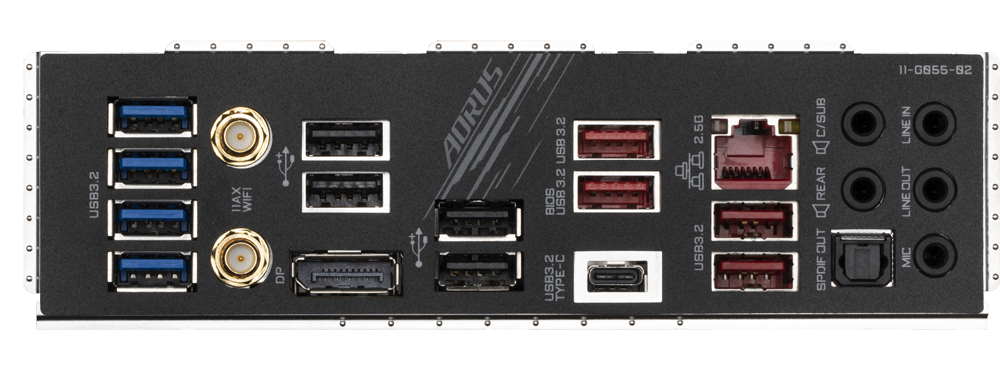
The rear IO area is dominated by a menagerie of USB ports. From USB 2.0 to USB 3.2 Gen 2x2 Type-C, you’ll find it here on one of the 13 ports. The IO plate itself comes preinstalled, and its black background and Aorus branding match the rest of the board. There’s a total of four USB 3.2 Gen 2 ports, four USB 3.2 Gen 1 ports, four USB 2.0 ports and finally, The 3.2 Gen 2x2 Type-C port. If you run out of USB ports on this board, you may want to reevaluate your life/peripheral choices--or you could just plug into one of the two previously mentioned USB-C front-panel headers. Video output (when using the integrated graphics on the CPU) comes from a single DisplayPort Port. In addition to the 2.5 GbE port are Wi-Fi antenna connections, and finally, the 5-plug plus SPDIF audio stack.
MORE: Best Motherboards
MORE: How To Choose A Motherboard
MORE: All Motherboard Content

Joe Shields is a staff writer at Tom’s Hardware. He reviews motherboards and PC components.
-
Co BIY This board is pretty much exactly what I am looking for ... at about twice what I want to pay.Reply
And that's about average for everything. -
Paytaxeshailsatan This review states that there are more m2 slots that are pci-e 4.0 than gigabyte claims. Only one m2 slot is 4.0 and that’s only if you’re using an 11th gen processor. Gigabyte claims the same caveat for the pciex16 for the gpu.Reply
basically it’s great for an 11th gen Intel cpu, but if you’re running a 10th gen, then it’s missing out on some of the features.
